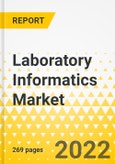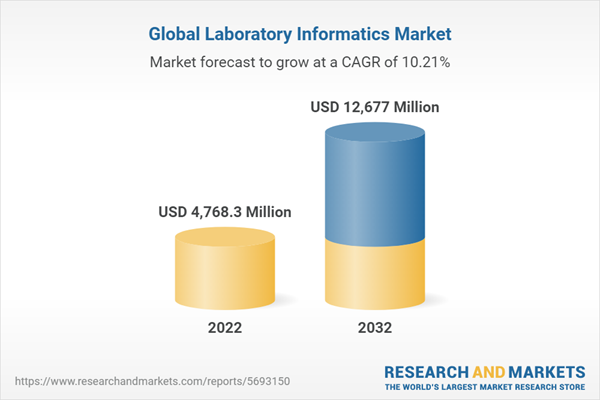Increasing Implementation of Laboratory Informatics in All Industries
This report comes with 10% free customization, enabling you to add data that meets your specific business needs.
The global laboratory informatics market was valued at $4,341.2 million in 2021 and is anticipated to reach $12,677.0 million by 2032, witnessing a CAGR of 10.27% during the forecast period 2022-2032. The growth in the global laboratory informatics market is expected to be driven by the increased efficiency of laboratories due to their usage and better data management. Additionally, it saves time and money.
Market Lifecycle Stage
Laboratory informatics plays an essential role in laboratories fulfilling quality standards, eliminating transcribing mistakes, shortening the time it takes from specimen receipt to results reporting, and improving patient outcomes. Over the last decade, technical developments in laboratory equipment have resulted in increasing specimen numbers, as well as a growing need for and dependence on laboratory data to support clinical and public health demands. These advancements indicated that paper-based record keeping and results reporting were impractical and could not serve the laboratory's commercial demands. As a result, there has been a significant increase in the need for laboratory informatics adoption at all levels. This expanded usage of laboratory informatics has enabled end customers to describe particular system requirements, prompting suppliers to design more appealing and practical products and feasible laboratory informatics choices.
Impact
- The presence of major instrument providers of laboratory informatics has a major impact on the market. For instance, in June 2020, Agilent Technologies, Inc. and Thermo Fisher Scientific Inc.'s expanded multivendor control approach to laboratory informatics enables clients to pick the finest hardware and software for their needs. This execution of its mutual compatibility principle would allow customers of Agilent Technologies and Thermo Fisher Scientific to select a chromatography data system from either company Agilent OpenLab CDS or Thermo Fisher Chromeleon to manage analytical instruments from both companies.
- Companies such as IDBS (Danaher.) partnered with Synthace in December 2021 in order to provide IDBS Polar users with cutting-edge data infrastructure for high-throughput process development (HTPD) studies. Synthace's cloud-based automation platform works in tandem with Polar's HTPD to accelerate bioprocess development by enabling better decision-making through more reliable data sets, comprehensive data analysis, and modern enterprise data management, allowing the team to adopt a faster throughput approach and significantly reduce timelines. This combined solution allows users to scale safely to hundreds of automated, parallelized experiments per month.
Impact of COVID-19
During the COVID-19 pandemic, the development of laboratory software and technologies really took off as people were working remotely, and thus digital solutions became a requirement for a productive laboratory. Also, increased laboratory demands for testing, genomics, drug development, and vaccinations also meant they had to become more efficient and provide faster, quicker, and more efficient results. In addition to this, these demands had to be fulfilled with laboratory space restrictions and demanding timelines. Thus, scaling up testing and research could only be solved by using laboratory informatics tools like LIMS and ELN. These tools helped scientists collaborate and work better even in a reduced-capacity working environment.
Many laboratory informatics manufacturers fastened their implementation process to help laboratories better fight the coronavirus. For example, CloudLIMS helped multiple labs set up within less than a week by implementing FDA-approved and preconfigured workflows. The key challenges faced by laboratories testing COVID-19 included rapid configuration of FDA-approved workflows, standardization, and validation of new COVID-19 testing methods, reporting results according to FDA and CDC guidelines, and following the internal regulatory CLIA ISO and HIPAA guidelines.
Market Segmentation
Segmentation 1: by Type
- Laboratory Information Management Systems (LIMS)
- Electronic Lab Notebooks (ELN)
- Chromatography Data Systems (CDS)
- Electronic Data Capture (EDC)
- Clinical Data Management Systems (CDMS)
- Laboratory Execution Systems (LES)
- Enterprise Content Management (ECM)
- Scientific Data Management Systems (SDMS)
- Quality Management Systems (QMS)
Based on type, the global laboratory informatics market is expected to be dominated by laboratory information management systems (LIMS). This is due to the high number of applications performed by LIMS and its ease of integration with other systems.
Segmentation 2: by Offering
- Platform
- Standalone
- Add-On
Based on offering, the global laboratory informatics market is dominated by standalone systems. However, platform is the fastest growing segment. This is because laboratories are realizing the need for more than one laboratory informatics system type, which is easier to integrate with platforms.
Segmentation 3: by Component
- Software
- Consulting Service
Based on component, the global laboratory informatics market is expected to be dominated by software. This is due to the higher number of software companies than consulting ones.
Segmentation 4: by Deployment
- On-Premises
- Cloud-Based
- Remotely Hosted
Based on deployment, the global laboratory informatics market is dominated by the cloud-based segment. The growth of the cloud-based segment is primarily attributed to its low cost and improving privacy concerns.
Segmentation 5: by End User
- Pharma and Biotechnology
- Biobanks and Biorepositories
- Molecular Diagnostics and Clinical Research Labs
- Contract Research Organizations (CROs)
- Academia
- Food and Beverage
- Chemical Industry
- Petrochemical Refinery and Oil and Gas Industry
Based on end user, the global laboratory informatics market was dominated by pharma and biotechnology. The growth of this segment is primarily attributed to the high use of laboratories in these fields. Additionally, with many software specifically designed to be used by this end user, their use is growing significantly.
Segmentation 6: by Region
- North America
- Europe
- Asia-Pacific
- Latin America
- Rest-of-the-World
North America dominated the global market with a revenue of $1,773.5 in 2021. However, the Asia-Pacific region, constituting several emerging economies, is expected to register the highest CAGR of 11.55% during the forecast period 2022-2032.
Recent Developments in the Global Laboratory Informatics Market
- In February 2022, Agilent Technologies, Inc. acquired advanced artificial intelligence (AI) technology developed by Virtual Control. With this acquisition, the company incorporated ACIES software into the industry's premier gas chromatography and mass spectrometry (GS/MS) platform, which boosted productivity, efficiency, and throughput in laboratories worldwide.
- In October 2021, PerkinElmer, Inc. introduced Signals Research Suite, a complete cloud-based solution hosted on Amazon Web Services. The suite is a secure informatics platform that provides pharmaceutical and industrial companies with comprehensive, end-to-end scientific data and workflow management.
- In July 2021, Abbott's STARLIMS Corporation upgraded to Technology Platform v12.2. Functionality and upgrades have been improved, and all of the features from prior versions of ELN are available in HTML5: Standard Operating Procedures (SOP) document viewer. The new HTML5 design enhanced start-up efficiency, integration, and usability.
- In August 2020, Thermo Fisher Scientific expanded SampleManager LIMS software deployment model choices which enabled laboratories with end-to-end support for software deployment in the Amazon Web Services (AWS) cloud. The customers of LIMS software can use the system's enhanced functionality and integration capabilities without investing considerable resources in the setup and continuing administration of a cloud environment.
Demand - Drivers and Limitations
Following are the demand drivers for the global laboratory informatics market:
- Reduced Human Error and Increased Efficiency
- Time Savings and Increased Revenue
- Increasing Implementation of Laboratory Informatics in All Industries
The market is expected to face some limitations too due to the following challenges:
- Slow Speed of Implementation
- Trained Professionals Needed
- Data Migration Highly Error-Prone and Time Consuming
How can this report add value to an organization?
Product/Innovation Strategy: The report considers both software and services-based companies. The industry is seeing constant development and product launches with new and innovative upgrades. Additionally, emerging technologies like AI and ML are also expected to be integrated into laboratory informatics systems soon, which is expected to further boost the market growth.
Growth/Marketing Strategy: The key components in laboratory informatics are the software and consulting services. The cost of software depends on the number of integrations you want the software with. However, the consulting charges usually surpass the cost of instruments, and consulting services are necessary to ensure the purchase of the right type of instruments and their correct integration and placements.
Competitive Strategy: The key players in the global laboratory informatics market have been analyzed and profiled in the study, consisting of both software-based and service-based companies, as well as a few emerging companies. Moreover, a detailed competitive benchmarking of the players operating in the global laboratory informatics market has been done to help the reader understand how players stack against each other, presenting a clear market landscape. Additionally, comprehensive competitive strategies such as partnerships, agreements, and collaborations will aid the reader in understanding the untapped revenue pockets in the market.
Key Market Players and Competition Synopsis
The companies that are profiled have been selected based on inputs gathered from primary experts, analyzing company coverage, product portfolio, and market penetration.
Some of the prominent names established in this market are:
Company Type 1: Public Companies
- Agilent Technologies, Inc.
- Abbott. (STARLIMS Corporation.)
- BD.
- Bio-Rad Laboratories, Inc.
- Dassault Systèmes (Biovia)
- Danaher. (IDBS)
- Illumina, Inc.
- Merck KGaA
- PerkinElmer, Inc.
- Thermo Fisher Scientific Inc.
- Waters.
Company Type 2: Private Companies
- Accelerated Technology Laboratories, Inc.
- CSols Inc.
- LabVantage Solutions Inc.
- LabWare
- MGI Tech Co., Ltd.
- Benchling.
- LabLynx, Inc.
Table of Contents
Companies Mentioned
- Agilent Technologies, Inc.
- Abbott. (STARLIMS Corporation.)
- Accelerated Technology Laboratories, Inc.
- BD.
- Bio-Rad Laboratories, Inc.
- Benchling.
- CSols Inc.
- Dassault Systèmes (Biovia)
- Danaher. (IDBS)
- Illumina, Inc.
- LabVantage Solutions Inc.
- LabWare
- LabLynx, Inc.
- Merck KGaA
- MGI Tech Co., Ltd.
- PerkinElmer, Inc.
- Thermo Fisher Scientific Inc.
- Waters.
Table Information
| Report Attribute | Details |
|---|---|
| No. of Pages | 269 |
| Published | November 2022 |
| Forecast Period | 2022 - 2032 |
| Estimated Market Value ( USD | $ 4768.3 Million |
| Forecasted Market Value ( USD | $ 12677 Million |
| Compound Annual Growth Rate | 10.2% |
| Regions Covered | Global |
| No. of Companies Mentioned | 18 |









